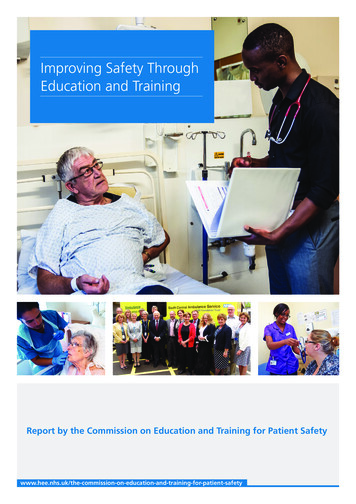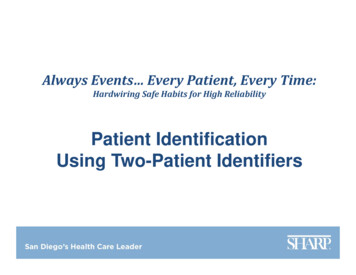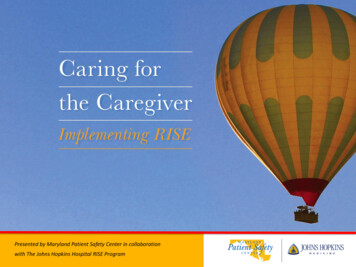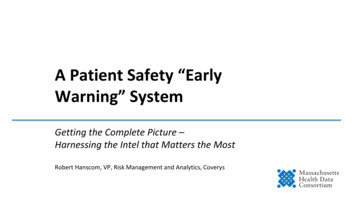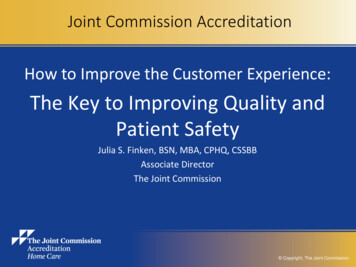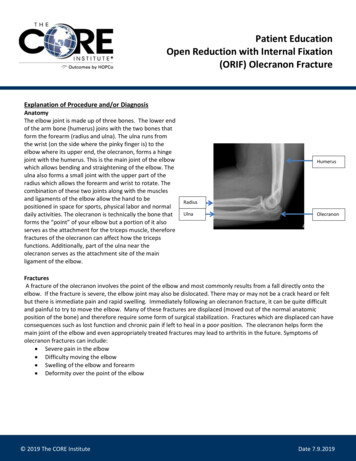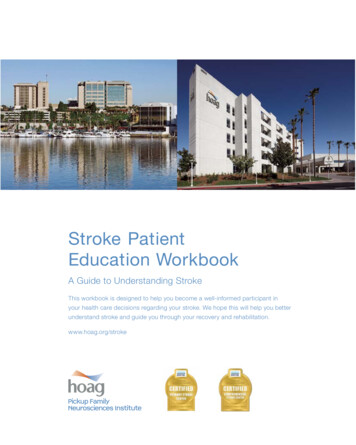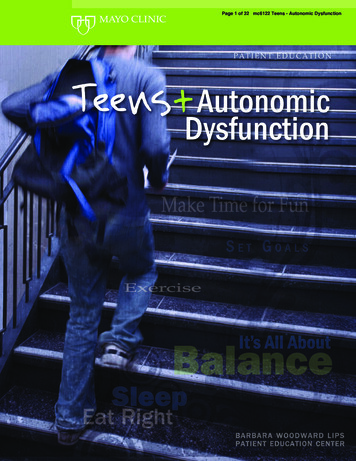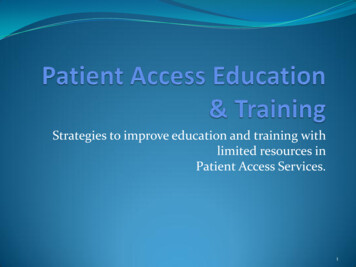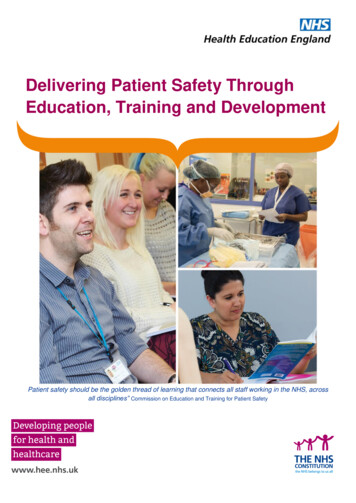
Transcription
Delivering Patient Safety ThroughEducation, Training and DevelopmentPatient safety should be the golden thread of learning that connects all staff working in the NHS, acrossall disciplines” Commission on Education and Training for Patient Safety
Delivering patient safety througheducation, training and developmentExecutive summaryThe Commission on Education and Training for Patient Safety published its report ImprovingSafety Through Education and Training in 2016. Since that time Health Education England (HEE)has been delivering against the recommendations within the report nationally, regionally and incollaboration with system partners. This has set a firm grounding for the next phase ofeducational development required to deliver the Patient Safety Strategy identified within the LongTerm Plan for the NHS.Patient safety is a key part of the quality of healthcare services; patient safety, patient experience,and service efficacy. As such there are many development activities that overlay these domains.Delivering educational activities to improve patient safety often overlaps with other initiatives suchas quality improvement, human factors, and simulation based education. This paper outlinessome of the many initiatives which HEE has commissioned, sponsored and promoted in supportof patient safety within healthcare practice.
Delivering patient safety througheducation, training and developmentIntroductionPatient safety is everyone’s responsibility. It is the responsibility of every member of staff andevery part of the system. Within that system HEE has a duty to ensure that:1. learners on HEE commissioned programmes are learning safe practices,2. learners understand the importance of safety and how to deliver safe healthcare, and3. that the learning we commission is effective at enhancing patient safety.In March 2016 the Commission on Education and Training for Patient Safety published its report‘Improving Safety Through Education and Training’1. This report established a vision for howeducational resources and the levers available to Health Education England can be applied todeliver a long-term plan for change. Since the publication of the Report, HEE has been workingthrough its regional and local structures to enhance patient care through education, training anddevelopment activities throughout the NHS. This paper demonstrates some of the work HEE hasundertaken to embed the recommendations of the Commission into educational practice andoutlines the next steps to delivering ever safer healthcare practice.Health Education England has worked in collaboration with system partners and providers todeliver the work of the Commission in the context of a dynamic and changing health and socialcare environment. NHS service providers, in partnership with HEE local offices, are implementingmany education, training and development initiatives to promote safe clinical practice acrosshealth and care services and work is taking place across the strategic bodies to ensure anawareness of patient safety issues is developed throughout the workforce.The publication of this report coincides with the publication of several strategic policy documentswhich talk to patient safety in the NHS: The Care Quality Commission report into ‘Never events’, Opening the Door to Change2,NHS Improvement (NHSI) consultation to develop a Patient Safety Strategy for the NHS3,NHS England (NHSE) ‘Long Term Plan’ for the NHS4.The safety of patients is paramount and cannot be compromised, and Health Education Englandhas a Patient Safety Programme Board which oversees the strategic delivery of education topromote safe healthcare practice throughout the NHS. It is the responsibility of HEE to ensuresufficient high-quality educational resources are available and to ensure staff are sufficientlyknowledgeable and skilled to practise safely.Patient safety is a complex issue; by the very nature of healthcare, a degree of hazard is inherentin a significant proportion of NHS activities. This makes healthcare comparable with other cations/themed-work/opening-door-change3 and-delivery-management/patient-safety-strategy/4 https://www.longtermplan.nhs.uk/2Delivering Patient Safety Through Education, Training and Development 20193
Delivering patient safety througheducation, training and developmentThe NHS should continually andforever reduce patient harm byembracing wholeheartedly anethic of learningA Promise to Learn, A Commitment to Actrisk industries’ such as nuclear and aviation (TedBaker, CQC5). As with those industries, patients andthe public rightly expect NHS care to be safe6.Learning, both in respect of the learning forindividuals and in developing the NHS to become alearning organisation, are key to ensuing patientsafety7.Safe practice is an integral element of high qualitycare; it is the fundamental expectation that our patients, the public, and our staff have of the NHS.Services which are not in the first instance safe, fail all other criteria for quality.ContextThe NHS has, throughout its history, striven to address patient safety issues and has, during thattime, continued to become safer and safer.In recent years there has been an increasing focus on patient safety within the NHS. There isgreater awareness of patient safety issues within healthcare, as well as an increasing awarenessof quality improvement methodologies to improve patient safety. Notwithstanding that, the NHSstill faces significant challenges in developing and embedding a consistent culture of patientsafety8.Don Berwick supported the long-standing idiom that ‘culture trumps strategy’, stating “A saferNHS will depend far more on major cultural change than on a new regulatory regime” 9. Education,training and development play an important part in culture change and, whilst culture changewithin clinical services cannot be implemented by national bodies, it is possible to facilitate thedevelopment of a learning culture with patient safety at its heart through the provision of thenecessary educational support and infrastructure to inform and motivate staff. Recentpublications by the Care Quality Commission10 and NHS Improvement11 refer to the importanceof culture for patient safety.The importance of patient safety, and the complex nature of the NHS, means that safety cannotbe the responsibility of any one organisation. Important as education and training is, many otherbodies also have a part to play in ensuring safety in the NHS. Organisations such as the CareQuality Commission12 and Healthcare Safety Investigation Branch13 play an important part inmonitoring the safety of services and recommending improvement. Service and professionalregulators such as NHS Improvement14, General Medical Council15 and Nursing & es/20181224 openingthedoor tem/uploads/attachment data/file/226703/Berwick Report.pdf8 er e-nhs-14-dec-2018-v2.pdf9 Don Berwick presentation to Kings Fund 06.09.201310 4 openingthedoor report.pdf11 er /about-us/14 -safety/15 ---safety-and-quality6
Delivering patient safety througheducation, training and developmentCouncil16 have a role in setting the standards for safety in learning and in practice. National andregional commissioning agents, NHS England17 and Sustainability and TransformationPartnerships/ Integrated Care Systems18 have a responsibility to understand the factors that affectpatient safety and to commissioning services with patient safety at the heart. Universities, RoyalColleges and practice learning providers are key to teaching safety and setting a supportiveculture for patient safety19. Patient safety requires a system wide approach with knowledge, skillsand culture at the heart.Rising to the challengeImproving Safety Through Education and Training20 clearly identified the important part learningand development plays in changing culture and enhancing practice. This created a fantasticopportunity for educational policy and delivery leads to focus on patient safety as a priority forprovision, based on the vision created by the Commission. Since the publication of the report,much work has taken place across the English healthcare system, in partnership with universityproviders, clinical leads, Academic Health Science Networks, Royal Colleges, and many otherparties. The report also identified the variety of intelligence available (academic and clinical) topromote safety in practice.Improving Safety Through Education and Training recommendations:1. Ensure learning from patient safety data and good practice2. Develop and use a common language to describe all elements of quality improvementscience and human factors with respect to patient safety3. Ensure robust evaluation of education and training for patient safety4. Engage patients, family members, carers and the public in the design and delivery ofeducation and training for patient safety5. Supporting the duty of candour is vital and there must be high quality educational trainingpackages available6. The learning environment must support all learners and staff to raise and respond toconcerns about patient safety7. The content of mandatory training for patient safety needs to be coherent across the NHS8. All NHS leaders need patient safety training so they have the knowledge and tools to drivechange and improvement9. Education and training must support the delivery of more integrated ‘joined up’ care10. Ensure increased opportunities for inter-professional learning11. Principles of human factors and professionalism must be embedded across education andtraining12. Ensure staff have the skills to identify and manage potential /18 s/#one19 https://www.nhsemployers.org/search-results?q safety20 20training.pdf17Delivering Patient Safety Through Education, Training and Development 20195
Collaborating for impactHealth Education England cannot deliver the learning and the culture change necessaryto improve patient safety alone. Every patient expects safe care21, and each of thestrategic bodies of the NHS have their part to play, and so too do the professional andsystem regulators, education and service providers, and other parts of the NHS system.HEE has taken an approach of working in partnership with other agencies and providersto deliver change. This has strengthened the system-wide ability to deliver improvedpatient care: building on the networks of others toincrease reach,using expertise and capability where itexists to maximise productivity,getting closer to frontline services inrespect to educational need,developing a culture that promotes theimportance of patient safety through thelevers of education, training &development.“Every patient – whether inhospital, at home, in a GPsurgery – expectscompassionate, effective andsafe care.”Matt Hancock, Secretary of State, 2018Health Education England is an active member of the Joint Strategic Oversight Group,collaborating with other strategic bodies to oversee the quality and safety of patient careacross the NHS. We have also developed a memorandum of understanding with theHealthcare Safety Investigation Branch22 to share non-confidential intelligence to improvepatient safety. We are working in collaboration with NHS Improvement to bring forwardan implementation plan for the necessary training and development to deliver theemerging NHS strategy for patient safety. HEE has strong collaborative relationshipswith service providers, the professional regulators and professional royal colleges toenhance the quality and safety of education provision.Supports delivery of recommendation 1Technology enhanced learninge-Learning has, in recent years, become a significant source of learning for the healthand care workforce; providing a cost-effective means of delivering a variety of trainingto large numbers of staff in a readily accessible format.The primary source of e-learning for health and care staff is the HEE e-Learning forHealthcare (e-LfH) portal23. e-LfH has over 200 e-learning programmes, more than24,000 e-learning sessions and more than 900,000 registered users.Patient safety is an integral part of the working lives of all health and care staff; this isreflected by patient safety training being implicit within many of the learning afety-plan22 https://www.hsib.org.uk/23 https://portal.e-lfh.org.uk/6
available on the e-LfH platform. Furthermore, ‘patient safety’ is a specific andidentifiable aspect of many e-LfH
Improving Safety Through Education and Training recommendations: 1. Ensure learning from patient safety data and good practice 2. Develop and use a common language to describe all elements of quality improvement science and human factors with respect to patient safety 3. Ensure robust evaluation of education and training for patient safety 4. Engage patients, family members, carers and the public in

